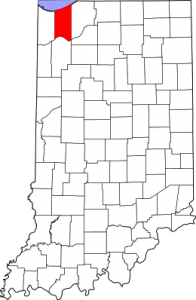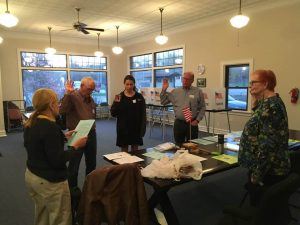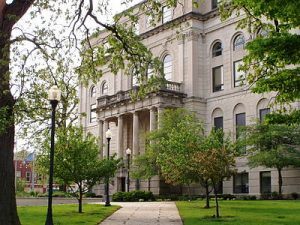by Carol Westbrook
I live in a flyover state, Indiana, USA. You know, one of those states that you fly over but you don’t stop in, as you travel East Coast to West Coast or the post-industrial Midwest. You know, the vast prairies where no one important lives, mostly rural and small town. Where the people are mostly white, socially conservative highly religious and staunchly Republicans. Where there are too few people to influence national politics. You know, the ones who put Donald Trump in office.
This May, I was the Election Inspector for the primaries in our precinct, Pine 2, of Porter County, Indiana. Porter County is not exactly flyover country–we’re more of a hybrid flyover/northern city. We are tucked into the northwest corner of Indiana, a region filled with heavy industry and a few large cities on the shores of Lake Michigan. Our population, 166,000, is only 3% that of Chicago, and is 93% white.
County, Indiana. Porter County is not exactly flyover country–we’re more of a hybrid flyover/northern city. We are tucked into the northwest corner of Indiana, a region filled with heavy industry and a few large cities on the shores of Lake Michigan. Our population, 166,000, is only 3% that of Chicago, and is 93% white.
Pine 2 is only 60 miles from Chicago and is filling with Chicago expatriates seeking lower property and sales tax, cheaper houses, or wooded country retreats an easy hour commute to Chicago. Pine 2 itself has no industry, but it includes my little town of Beverly Shores, which houses a high proportion of artists, intellectuals, Chicago commuters and retired University of Chicago professors. Democrats outnumber Republicans three to one. The other 132 precincts of Porter County, though, are truly flyover country. Forty percent is farmland; it is is dotted with small towns and small industry. It is socially and politically conservative, strongly religious, and staunchly Republican.
From a national perspective, this primary was low-key for the Democrats of Pine 2, as the candidates for US Senate and US House, Donnelly and Visclosky, were unopposed incumbent Democrats. On the Republican side, though, things were heating up, as they are trying to take back a US Senate seat which was surprisingly lost in 2016, when the long-term and much-beloved incumbent Dick Luger lost the primary to an aggressive Tea-Party backed candidate, Richard Mourdock. Too extreme even for the conservative voters of Indiana, the seat was taken by a Democrat, Joe Donnelly. In the May 2018 primary there were seven Republicans vying for the candidacy to unseat Donnelly, each of whom to a man (and one woman) was trying to be more “Trump” than the other. Their platforms were pro-family (anti-gay and anti-abortion), pro-gun, anti-immigration, pro-Wall–not that there are many illegal immigrants in our state.
Who will the Republicans choose to run against Donnelly? How can we tell them apart? We’ll find out at the end of the election day. Who would have thought primary elections could be so exciting in a flyover state?
As the Republican-appointed election Inspector, my job was to insure that the process ran smoothly and without fraud, that the ballots were handed out only to citizens who were legally eligible to vote in Pine 2, that no eligible voter was turned away, that the ballots were filled out and recorded in privacy. At the close of the polls at 6 pm, I had to make sure that every ballot was accounted for, returning the ballots and the voting machine chip to the County Office in Valparaiso. In this, I would be accompanied by the Democratic Judge.
My team consisted of two clerks and two judges, one from each party. The clerks’ job was check if the voter was on the list, ask for ID with address if requested, and give out one ballot– either Republican or Democrat. The judges’ job was to insure that there is no cheating, electioneering, or fraud. They could issue a provisional ballot if residency was in question. The two-party system provides a cross-check to make sure there is no funny business by the opposition party. Realistically, everyone knew everyone else, so it wasn’t easy to cheat.
There are about 800 voters in Pine 2, of whom about 600 reside in Beverly Shores and the rest in the unincorporated areas. The numbers are approximate, as the rolls indicate 1000 voters, but a name is not removed from the list unless the voter moves and registers in another precinct in Indiana, or returns the (occasionally) mailed postcard and checks “no longer reside at this address.” As you can imagine, the latter rarely happens. You may be asked to present a legal ID verifying your address. Or you may not. So it is technically possible to vote both in Pine 2 and in another state, for example in Chicago, Illinois. It’s been known to happen.
We met at 5:15 am and I swore in my team, as you can see on the right. We set up the “voting machine.” No dangling chads for us! We are thoroughly modern, and we have a voting machine. It scans the paper ballots, filled out with No. 2 pencils. Our “modern” equipment booted up in about 10 minutes, its boot-up screen indicating that it has the latest software–from 1995! This computer could not be hacked–it’s not connected to anything, and the code is probably written in an obsolete programming language.
for us! We are thoroughly modern, and we have a voting machine. It scans the paper ballots, filled out with No. 2 pencils. Our “modern” equipment booted up in about 10 minutes, its boot-up screen indicating that it has the latest software–from 1995! This computer could not be hacked–it’s not connected to anything, and the code is probably written in an obsolete programming language.
I opened the polls at 6 am. Tradition required me to walk outside and yell “Hear Ye! hear Ye! The Polls are open!” Voting started with the pre-commute rush. The clerks checked in each voter, counter-signed their signatures, and issued them the party ballot they requested. In Indiana, you may vote in either, and you will automatically become a member of that party, and go on their rolls as such. Quite a few dyed-in-the wool Democrats as well as staunch Republicans were not aware of this fact, and many switch hitters were surprised to learn that they had joined the other team at the last primary when they sought to “vote out” a presidential candidate they found particularly offensive.
I gave civics lessons throughout the day. This is a primary election, I tell them; you are indicating to your party who you want as the candidate in the November elections. Yes, this means you will become a member of that party until the next primary. No, this does not mean you have vote for this party in the November elections, you can still vote your choice. No, you cannot have an Independent Ballot, there is no such thing. No, can’t vote in both, you must chose one or the other. Yes, you have to be a registered resident of this precint to vote here.
I stood at the voting machine, assisted voters who needed help inserting the ballots, and provided replacements if theirs was rejected and needed to start over. I’d have to save and return the spoiled ballot for final accounting. I gave each voter a sticker saying, “I count. I voted today,” and showed them where to exit.
The stickers backfired when I gave them to some children who had accompanied their mother to the polls. These four children, ages about 3 to 12, sitting quietly in a row by height, were obviously home-schooled, and interested in the process. Kids love stickers, right? But the oldest child refused his, saying, “I can’t wear it. It’s a lie. I didn’t vote and won’t be able to for six years.” His siblings walked back and returned theirs to me. Grass roots honesty.
Soon it was lunch. In true Hoosier style, we had pot-luck. A crock-pot of barbecue pork appeared, someone else brought buns and plates, and I made coleslaw. Delicious! And we could keep our $15 stipend.
The day wore on; there was little excitement. A young man came in to vote but he had moved and was no longer on the rolls. He was puzzled, but he left. We were visited by an elderly couple, part-time residents of Beverly Shores who lived in Florida. The wife was registered here and her husband in Florida–for the tax benefits. Perfectly legal, but we couldn’t let him vote here. His wife was angry, stating that “they always gave him a ballot here before, no one asked him for an ID!” Our clerks and judges refused to budge, and the couple stormed out.
The mid-afternoon lull. No voters for a few hours but we couldn’t leave until the polls closed at 6 pm. Time to open the absentee ballots and scan into the machine. Done. The coffee pot went on, the cookies came out, as did the stories. Chicago voting is the stuff of legend. Someone  heard that voters in Chicago were allowed to vote for their deceased parents, still on the voters’ rolls, “if they knew how their parents would have voted.” Democratic, of course! Possibly true. Someone in Chicago had registered their dogs to vote. Possibly true. Years ago the Democratic captain in our precinct would go into the booths with the voters to “help” them vote. Not likely in Pine 2. My poll workers had taken an oath to uphold, and they were honest to a fault.
heard that voters in Chicago were allowed to vote for their deceased parents, still on the voters’ rolls, “if they knew how their parents would have voted.” Democratic, of course! Possibly true. Someone in Chicago had registered their dogs to vote. Possibly true. Years ago the Democratic captain in our precinct would go into the booths with the voters to “help” them vote. Not likely in Pine 2. My poll workers had taken an oath to uphold, and they were honest to a fault.
Six pm and I closed the polls. The clerks counted up the used ballots and the signed voters. The judges and I counted the cast and spoiled ballots. The machine printed a tally. Everyone held their breath as I compared the number. Yes! The counts matched! 230 ballots, 40% Republican and 60% Democratic. That’s almost a 25% turnout, pretty good for a primary. The judge and drove to the county seat in Valparaiso, above, to deliver the ballots, the voting machine chip and the machine printout; we waited in line with Inspectors from 132 other precincts. It was a long wait. We finally finished and returned home, feeling good about participating in the Democratic process.
And yes, I counted. And I voted.
